The most recent technology of Wi-Fi, referred to as Wi-Fi 6, brings with it some vital efficiency enhancements that intention to deal with limitations in older generations. Whereas loads of routers and purchasers are already obtainable with chips utilizing the 802.11ax certification, Wi-Fi 6 is simply starting its rollout. It would change into a part of the official IEEE specification in September 2020. That is ushering in a wave of up to date gadgets touting new wi-fi capabilities that can contribute towards next-generation networks with extra velocity and fewer congestion.
Earlier than we get too far, it is essential to know that 802.11ax, often known as “high-efficiency wi-fi,” is similar factor as Wi-Fi 6. It is simply simpler to say Wi-Fi 6 than 802.11ax.
It is a new naming customary set by the Wi-Fi Alliance, with earlier generations now being referred to as Wi-Fi 5 (802.11ac) and Wi-Fi 4 (802.11n). This labeling conference is anticipated to seem on gadgets as proven beneath.
Technically, Wi-Fi 6 has a single-user information charge that’s 37% quicker than 802.11ac, however what’s extra vital is that the up to date specification will provide 4 occasions the throughput per person in crowded environments, in addition to higher energy effectivity which ought to translate to a lift in gadget battery life.

To realize these enhancements, 802.11ax implements quite a lot of modifications together with a number of multi-user applied sciences which have been borrowed from the mobile trade – specifically MU-MIMO and OFDMA – strategies that significantly enhance capability and efficiency by enabling extra simultaneous connections and a extra thorough use of spectrum.
Dwelling customers who improve their {hardware} can look ahead to some enhancements from these applied sciences, particularly over time because the variety of gadgets per family will increase – some estimates counsel there will likely be as many as 50 nodes per residence by 2022.
Whereas Wi-Fi 6 is not designed to spice up obtain speeds considerably, the brand new options will actually shine as gadget rely in an space will increase. It has a extra nuanced method that’s anticipated to convey transfer advantages over time. This may in the end assist in laying a basis for the variety of nodes anticipated on upcoming sensible infrastructure (e.g. Web of Issues gadgets). Together with addressing overlapping protection from the sheer variety of gadgets and community deployments rising as IoT rolls out, Wi-Fi 6 will likely be geared up to deal with the ever-increasing demand for quicker multi-user information charges.
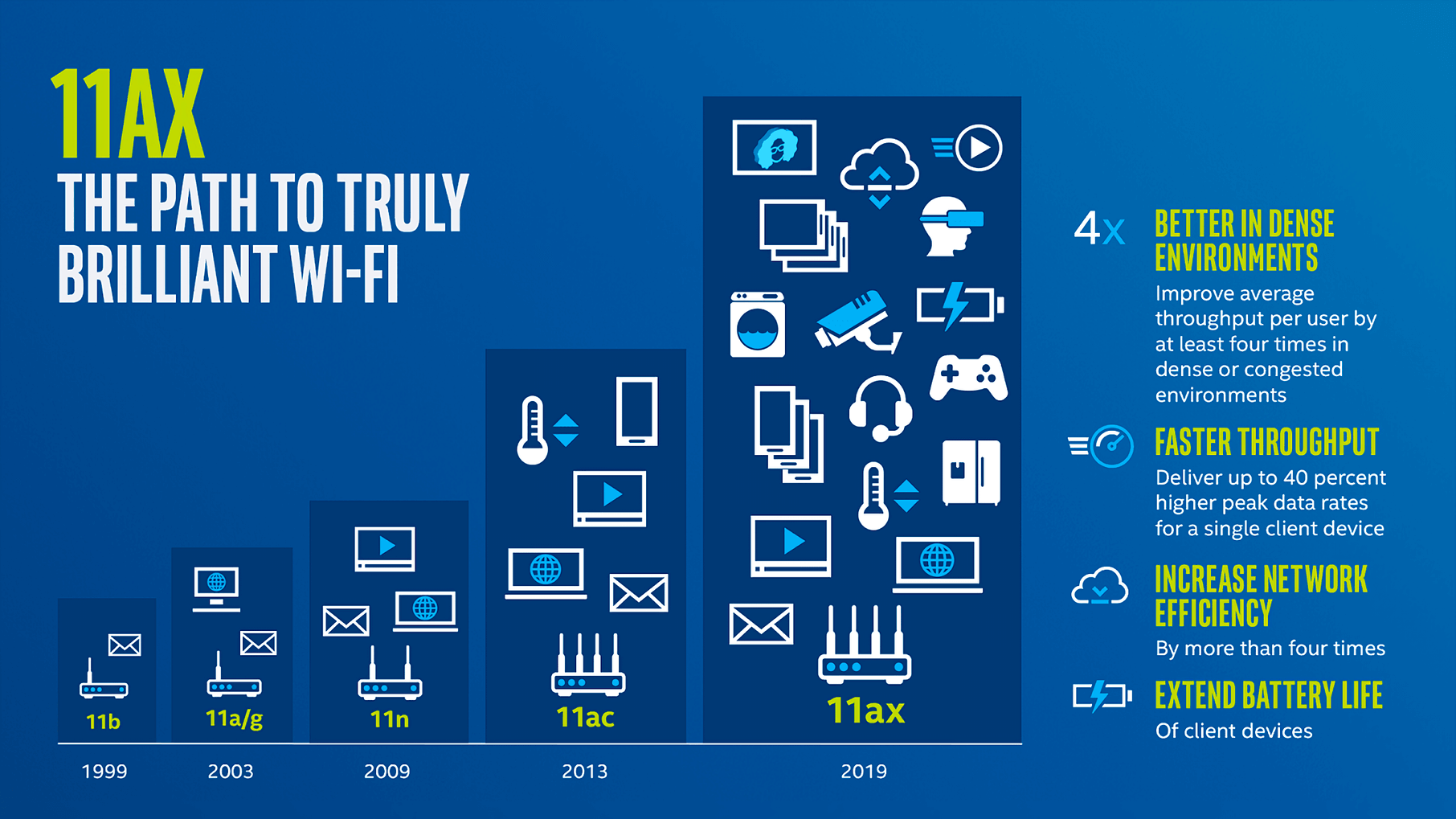
Total, Wi-Fi 6 builds on 802.11ac with greater than 50 up to date options initially proposed, although not all of them are included within the finalized specification.
This is a few of Wi-Fi 6’s most important advantages:
- Extra general bandwidth per person for ultra-HD and digital actuality streaming
- Help for extra simultaneous streams of information with elevated throughput
- Extra whole spectrum (2.4GHz and 5GHz, finally bands in 1GHz and 6GHz)
- Mentioned spectrum break up into extra channels to allow extra routes for communication
- Packets include extra information and networks can deal with completely different information streams directly
- Improved efficiency (as a lot as 4x) on the most vary of an entry level
- Higher efficiency/robustness in out of doors and multi-path (cluttered) environments
- Potential to dump wi-fi site visitors from mobile networks the place reception is poor
802.11n vs. 802.11ac vs. 802.11ax
| 802.11n (Wi-Fi 4) | 802.11ac Wave 2 (Wi-Fi 5) | 802.11ax (Wi-Fi 6) | |
| Launched | 2009 | 2013 | 2019 |
| Bands | 2.4GHz & 5GHz | 5GHz |
2.4GHz & 5GHz, spanning to 1GHz – 6GHz finally
|
| Channel Bandwidth |
20MHz, 40MHz (40MHz non-obligatory)
|
20MHz, 40MHz, 80MHz, 80+80MHz & 160MHz (40MHz assist made obligatory)
|
20MHz/40MHz @ 2.4GHz, 80MHz, 80+80MHz & 160MHz @ 5GHz
|
|
Subcarrier Spacing
|
312.5kHz
|
312.5kHz
|
78.125 kHz
|
|
OFDM Image Length
|
3.6us (brief guard interval) 4us (lengthy guard interval)
|
3.2us (0.4/0.8us cyclic prefix)
|
12.8us (0.8/1.6/3.2us cyclic prefix)
|
|
Highest Modulation
|
64-QAM
|
256-QAM
|
1024-QAM
|
|
Information Charges
|
Starting from 54Mb/s to 600Mb/s (max of 4 spatial streams)
|
433Mb/s (80MHz, 1 spatial stream) 6933Mb/s (160MHz, 8 spatial stream)
|
600Mb/s (80MHz, 1 spatial stream) 9607.8Mb/s (160MHz, 8 spatial stream)
|
|
Channel Configuration
|
Single Consumer MIMO & OFDM
|
Single Consumer MIMO & OFDM Wave 1, Multi Consumer MIMO & OFDM Wave 2
|
Multi Consumer MIMO & OFDMA
|
Launched in 2013, 802.11ac (now often known as Wi-Fi 5) was standardized in 2013. Whereas this specification is basically enough for at this time’s typical residence utilization, it solely makes use of bands within the 5GHz spectrum and lacks the extent of multi-user applied sciences that can assist a rising variety of gadgets linked directly.
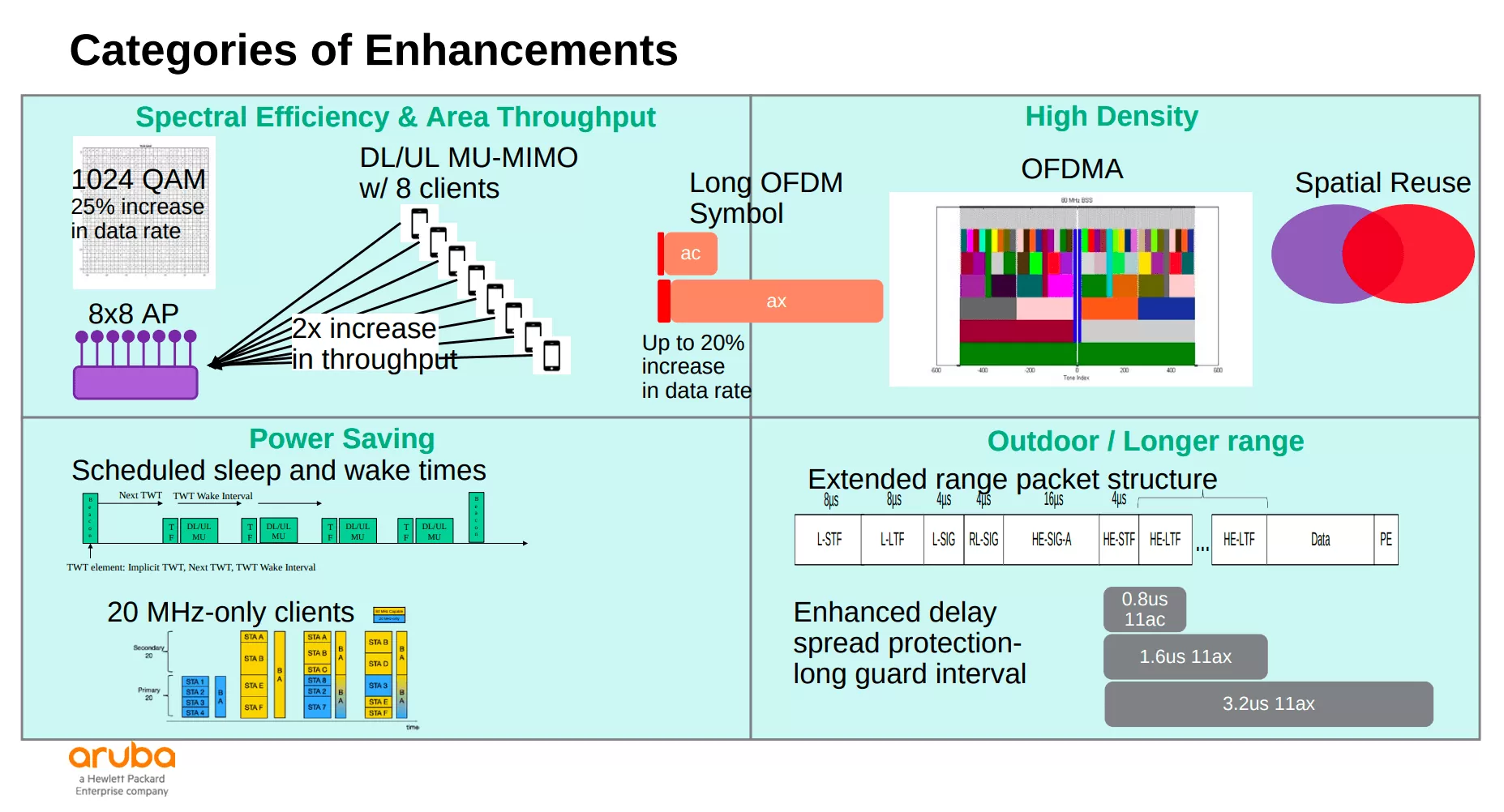
As some extent of reference for the modifications coming in Wi-Fi 6, here’s what 802.11ac (Wi-Fi 5) expanded on 802.11n (Wi-Fi 4):
- Wider channels (80MHz or 160MHz versus a max of 40MHz within the 5GHz band)
- Eight spatial streams as an alternative of 4 (spatial streams illustrated)
- 256-QAM versus 64-QAM modulation (transmits extra bits per QAM image)
- Multi-Consumer MIMO (MU-MIMO) on 802.11ac Wave 2, enabling 4 downlink connections directly as an alternative of just one on Single-Consumer MIMO (nonetheless 1×1 on uplink)
The specification is backward suitable with earlier requirements, incorporating each 2.4GHz and 5GHz together with finally increasing that spectrum to incorporate bands in 1GHz and 6GHz after they change into obtainable.
Maybe extra noteworthy than the inclusion of this extra spectrum are the applied sciences that can put this bandwidth to make use of. With extra spectrum obtainable, Wi-Fi 6 can break up the bandwidth into narrower (extra) sub-channels, creating extra avenues for purchasers and entry factors to speak together with enabling assist for extra gadgets on any given community. Within the older 802.11n, you would primarily solely have 3 separate channels going directly since there was a lot overlap. This makes crowded areas like residences a multitude since everybody’s router is stepping on every others. 802.11ac added further area within the 5GHz band, however 802.11ax does a significantly better job of dealing with this.
One other space to have a look at is multi-device efficiency on a single community. This is called A number of-Enter A number of-Output and permits a single gadget to speak over a number of channels directly. It is mainly like having a number of wi-fi adapters linked to the identical community. The extension of this on the entry level finish is named MU-MIMO or Multi-Consumer MIMO. Because the title suggests, it permits an entry level to hook up with a number of customers directly by MIMO.
Whereas Wi-Fi 5 can serve 4 customers on downstream directly courtesy of MU-MIMO – a substantial enchancment over the single-user MIMO on Wi-Fi 4 – this characteristic will not be a requirement and was solely added in newer 802.11ac gadgets. On paper, 802.11ax will improve that to eight customers on each up and downlink, with the potential to ship 4 simultaneous streams to a single consumer.
Nonetheless, uplink MU-MIMO is not prone to see a lot use. Few if any present gadgets can profit from 4 spatial streams, a lot much less the eight supported on Wi-Fi 6, as most present MU-MIMO-equipped smartphones and laptops solely have 2×2:2 or 3×3:3 MIMO radios.
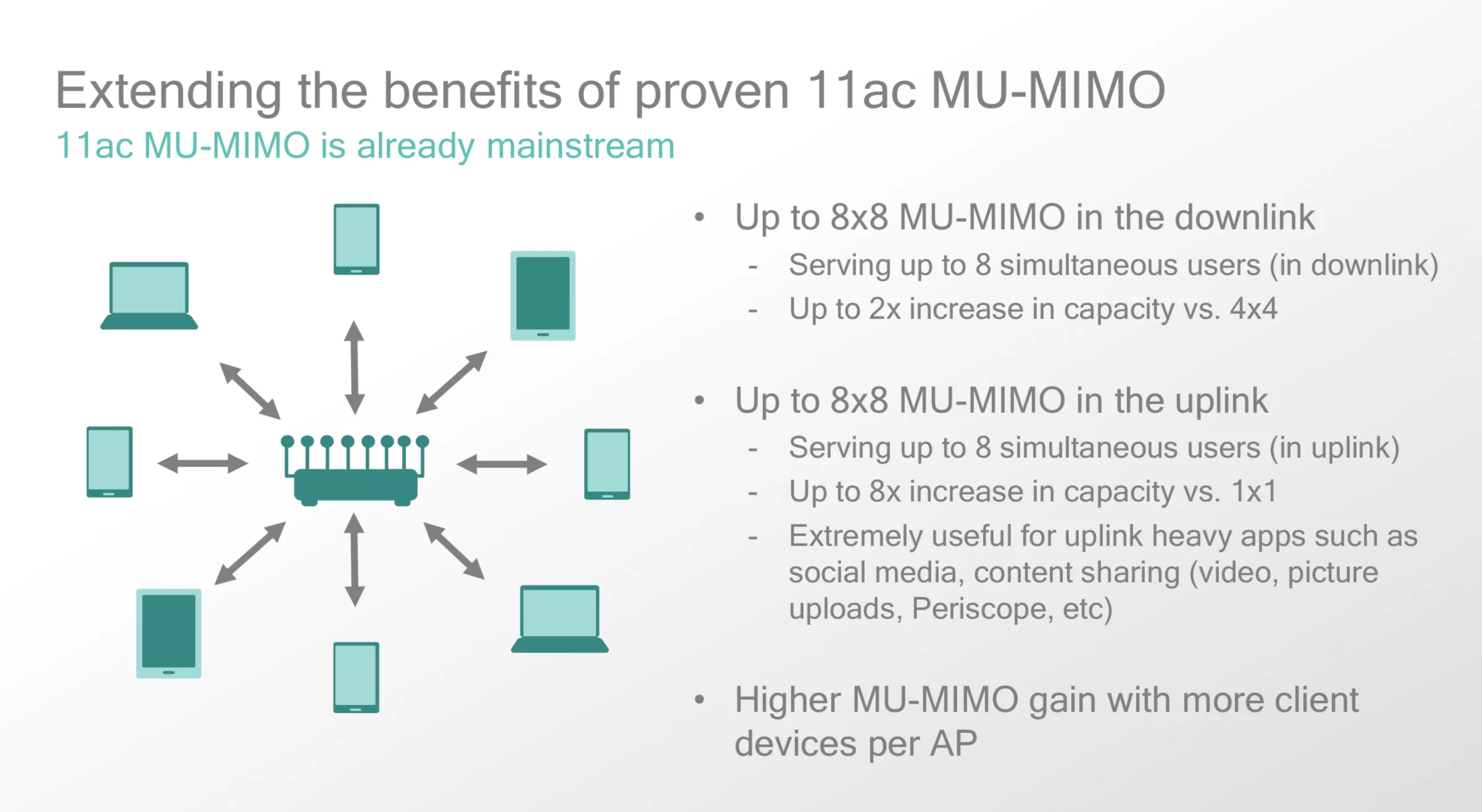
This quantity formatting (AxB:C) is used to reveal the utmost quantity of transmit antennas (A), the utmost quantity of obtain antennas (B) and the utmost quantity of spatial information streams (C) supported by a MIMO radio. Whereas a Wi-Fi gadget should assist MU-MIMO to immediately profit from that expertise, {hardware} with out MU-MIMO chips ought to not directly profit from the extra air time obtainable on MU-MIMO-enabled entry factors.
That can assist you visualize these applied sciences, as an alternative of 1 clerk serving a single line of shoppers individually, the mix of MU-MIMO and OFDMA may be equated to having many clerks and plenty of traces, with every clerk able to serving a number of clients directly. Additional, 802.11ax informs purchasers extra clearly when a router is accessible as an alternative of getting them contend for entry.
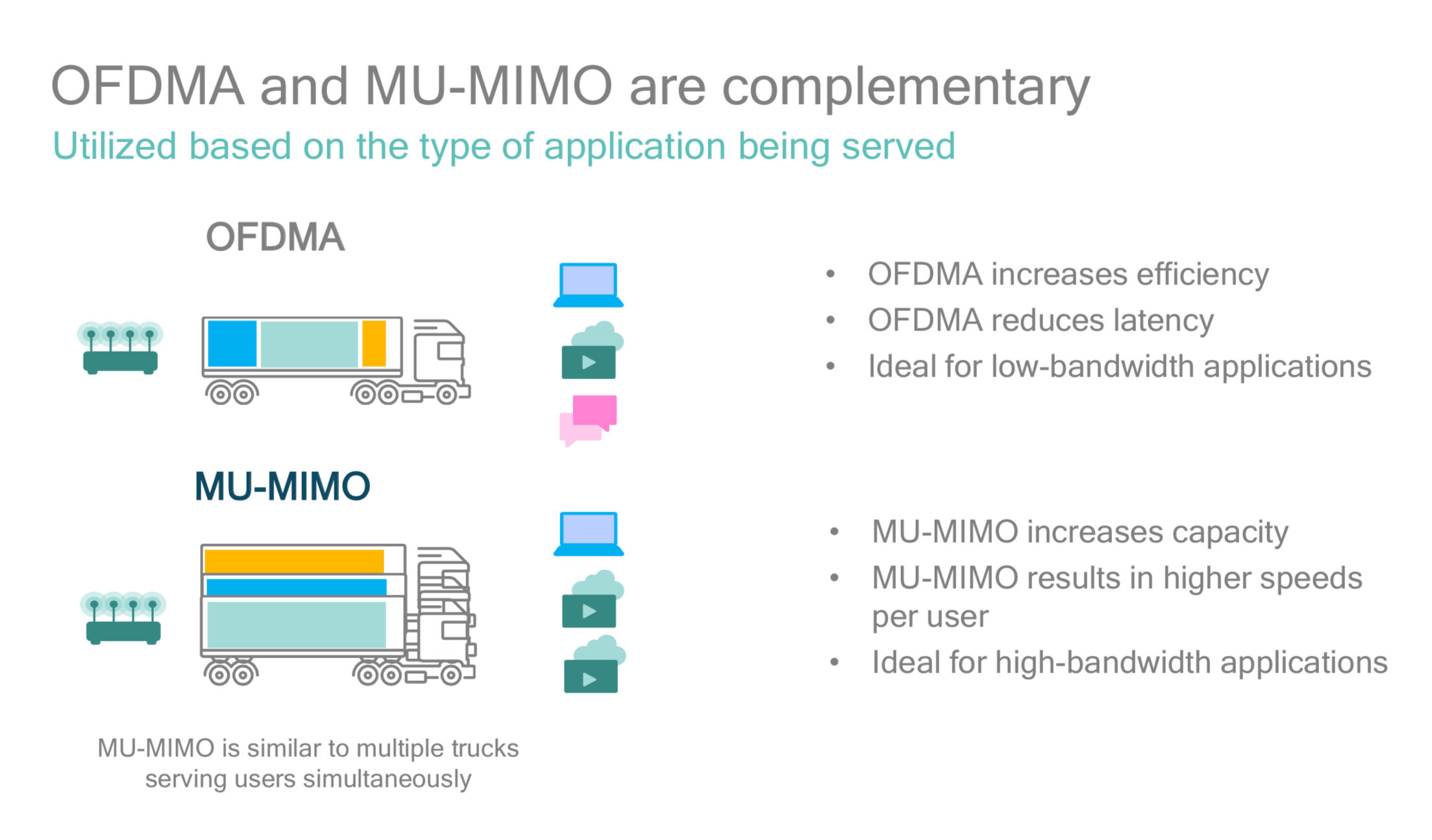
Though Wi-Fi 6’s general information charges and channel widths are much like Wi-Fi 5, dozens of applied sciences have been carried out to the up to date specification that ought to considerably enhance the effectivity and throughput of future Wi-Fi networks, which may probably serve dozens of gadgets on a single channel with speeds of a number of gigs a second. We’ll go over a few of them now.
OFDMA – Wi-Fi 6 additionally introduces assist for up and downlink “Orthogonal Frequency-Division A number of Entry” (OFDMA), a modulation scheme that’s equated to a multi-user model of OFDM (the spec on 802.11ac/n). OFDMA will cut back latency, increase capability and enhance effectivity by permitting as many as 30 customers directly to share a channel. This isn’t to be confused with Orthogonal Frequency-Division Multiplexing (OFDM) which is one thing completely different.
OFDMA permits for higher useful resource unit allocation in a given bandwidth. Included on Wi-Fi 6 so extra purchasers (as many as 30) can share the identical channel as an alternative of ready, whereas additionally bettering effectivity by combining completely different site visitors sorts. OFDMA is in contrast as a multi-user model of OFDM.
To oversimplify, OFDM splits up a channel into a number of subcarriers which permits a number of parallel information streams. Nonetheless, every person should use their full subcarrier. OFDMA however breaks these down additional into Useful resource Items which may be individually assigned. This fine-grained allocation is the important thing to OFDMA’s efficiency profit.

1024-QAM – The subsequent large efficiency enchancment is a bounce from 256-QAM to 1024-QAM. When a wi-fi gadget transmits a message, it should ship out an analog sign since there is not any option to immediately transmit binary information. This analog sign has two elements referred to as the amplitude (how highly effective the sign is) and the quadrature (how a lot the sign is shifted from a reference level). By controlling the quadrature and amplitude, we are able to successfully transmit digital information over an analog sign.
The 256-QAM system utilized in 802.11ac divides each the amplitude and quadrature into 16 predefined ranges. This offers a complete of 256 (16*16) doable transmission values and permits as much as 8 bits per transmission (2^8 = 256). Transmitter and receiver expertise has superior significantly since 802.11ac was launched, so we are actually capable of assign extra exact values to transmissions. As an alternative of dividing the quadrature and amplitude of a transmission into 16 doable values, 802.11ax can divide it into as much as 32 ranges. This offers us 1024 (32*32) doable transmission values and as much as 10 bits per transmission.
After all, as we pack increasingly information into the identical finite quantity of assets, our sensitivity and accuracy should additionally improve. A small error within the reception of a 256-QAM sign might not trigger an points, however since 1024-QAM packs symbols a lot nearer, the identical error might trigger an incorrect worth to be decoded. Gadgets are sensible sufficient to know that if many transmissions are being decoded incorrectly, they need to drop to a decrease scheme.
1024-QAM may end up in a theoretical single-stream information charge of 600Mb/s utilizing an 80MHz channel which is 39% higher than the theoretical 433Mb/s single-stream information charge of Wi-Fi 5.

Longer OFDM Symbols – Will increase the length that an OFDM image is transmitted from 3.2us on Wi-Fi 5 to 12.8us on Wi-Fi 6 and helps an extended cyclic prefix for every image.
A cyclic prefix (CP) provides a portion of the top of a OFDM image to the entrance of the payload to supply a guard interval towards intersymbol interference and to enhance robustness since this portion can be utilized if crucial. This determine may be adjusted relying on overhead necessities (an extended CP repeats extra information and occupies more room in an emblem, leading to a decrease information charge).
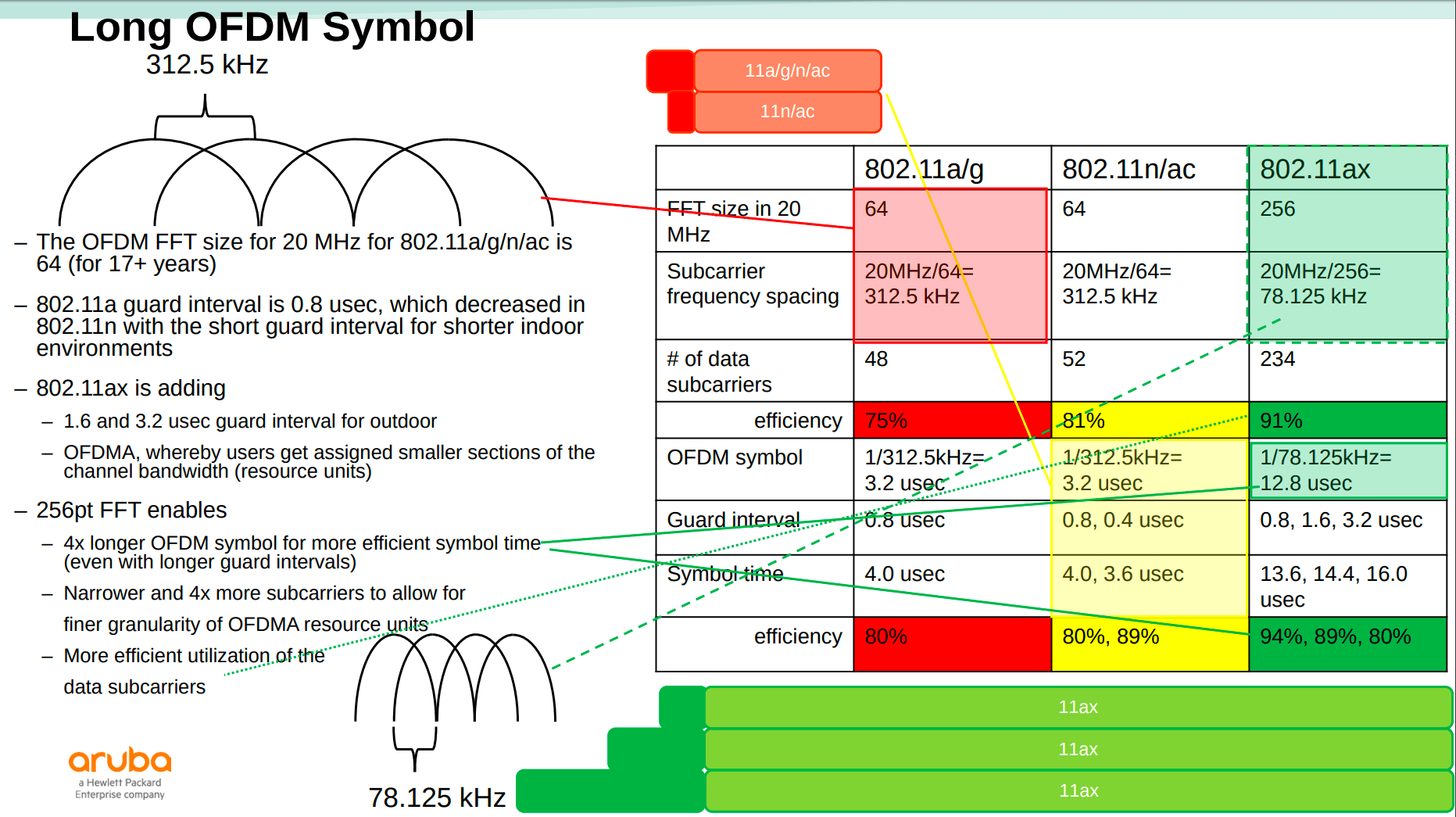
Dynamic fragmentation – Whereas Wi-Fi 5 has static fragmentation, which requires all fragments of a knowledge packet to be the identical measurement (apart from the final fragment), dynamic fragmentation permits these items to be of a various measurement for higher use of community assets.
Spatial frequency reuse/OBSS (BSS coloring) – If a number of entry factors are working on the identical channel(s), they will transmit information with a singular “coloration” identifier that enables them to speak over the wi-fi medium on the identical time with out ready as the colours allow them to distinguish between one another’s information.

Beamforming – Exists on Wi-Fi 5, although that customary helps 4 antennas and Wi-Fi 6 will increase this to eight. Beamforming improves information charges and extends vary by directing alerts towards particular purchasers as an alternative of in each path directly. This aids MU-MIMO, which does not work effectively with quickly transferring gadgets. Beamforming was optionally obtainable on Wi-Fi 4 gadgets however turned crucial with the implementation of MU-MIMO on Wi-Fi 5 Wave 2. By fastidiously controlling transmissions from a number of antennas, we are able to trigger their alerts to intrude on function and redirect the ensuing sign in a brand new path.
TWT (Goal Wake Time) – Wake-time scheduling as an alternative of contention-based entry. A router can inform a consumer when to sleep and when to wake, which is anticipated to make a substantial distinction in battery life since a tool will know when to pay attention on a channel.

Uplink useful resource scheduler – Equally, as an alternative of customers competing to add information as on older wi-fi networks, Wi-Fi 6 schedules uplinks to reduce conflicts, leading to higher useful resource administration. Everyone will get their very own slot to speak so no one has to shout or speak over different folks.
Set off-based Random Entry – Additionally reduces information collisions/conflicts by specifying the size of an uplink window amongst different attributes that enhance useful resource allocation and increase effectivity.
Two NAVs (Community Allocation Vector) – When a wi-fi station is transmitting, it advertises the length it is going to take to finish so different stations can set their NAV to keep away from conflicts when accessing the wi-fi medium. Wi-Fi 6 introduces two NAVs: One for the community that the station belongs to and one for neighboring networks. This must also cut back vitality consumption by minimizing the necessity for provider sensing.
Improved out of doors operation – A number of of those options will end in higher out of doors efficiency, together with a brand new packet format, longer guard intervals and modes for improved redundancy and error restoration.
Wi-Fi 6E: Increasing Wi-Fi 6 to Embody 6GHz
Wi-Fi 6E is the title of a brand new extension to the prevailing Wi-Fi 6 customary to suggest it is able to supporting all-new 6 GHz frequencies. This may add extra spectrum, greater throughputs, and decrease latency.
Business leaders akin to Qualcomm decided that enough high quality of service on future networks would require extra spectrum than both 2.4GHz or 5GHz can present. The two.4GHz band has lengthy been saturated by frequent electronics akin to microwaves. The opposite choice, 5GHz, has inadequate spectrum for wider bandwidth channels (akin to 80MHz or 160MHz) and parts of 5GHz are topic to restrictions that restrict its use.
In early 2020, the FCC gave official approval for Wi-Fi to increase its attain to an infinite swath of recent radio spectrum within the 6 GHz band within the US. Particularly, the brand new Wi-Fi 6E customary may have entry to 1.2 GHz, or 1,200 MHz of radio spectrum, starting from 5.9 GHz to 7.1 GHz (and incorporating all of the 6 GHz frequencies in between, therefore the 6 GHz references).
Customary Wi-Fi is going through a spectrum scarcity as a result of if the rising variety of gadgets getting used world wide and the addition of 6GHz will assist mitigate this drawback. As soon as allowed, 6GHz will facilitate continued Wi-Fi progress, in addition to different benefits akin to broader channel sizes and fewer interference from legacy Wi-Fi 4 (802.11n) and Wi-Fi 5 gadgets. Analysts predict approval will set off the fast adoption of the band by tools producers.

To place the brand new spectrum in perspective, even the widest connections for millimeter wave 5G—the quickest form of 5G connection available—are restricted to 800 MHz. In different phrases, the brand new Wi-Fi connections have entry to just about 1.5 occasions the quantity of frequencies to transmit on because the quickest 5G connections.
Theoretically, that implies that Wi-Fi 6E connection speeds may show to be considerably quicker than even one of the best that 5G has to supply. Plus, due to the fundamental legal guidelines of physics and sign propagation, Wi-Fi 6E protection can really be wider than millimeter wave 5G.
The influence of Wi-Fi 6E will really shine in extremely congested areas. Routers may have wider channels to work with to accommodate extra gadgets at greater throughput charges.
Wi-Fi 6 or 802.11ax is just one of many upcoming wi-fi requirements being developed to service the number of community calls for that will likely be made by various kinds of gadgets. 802.11ad/ay will convey multi-gigabit speeds by using millimeter wave frequencies. On the other finish of the spectrum, 802.11ah is designed for extremely low-power and will end in battery lifetime of a number of years.
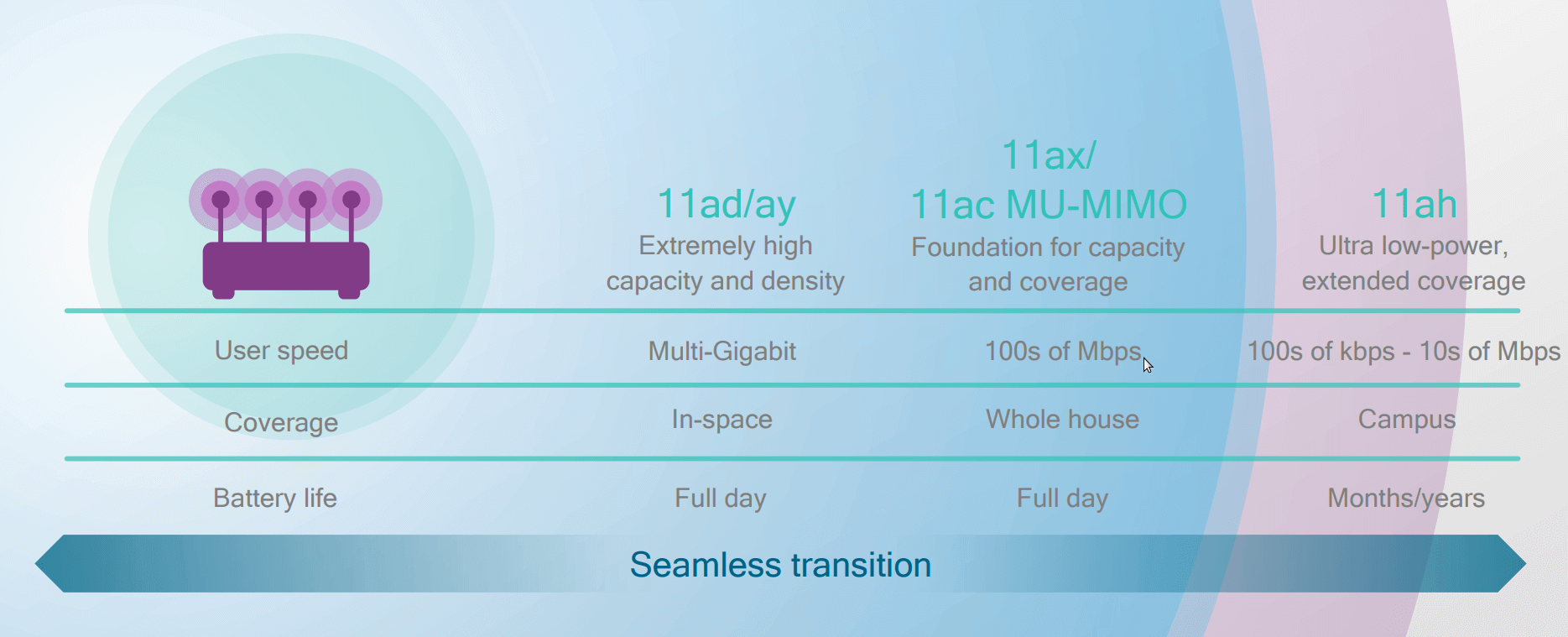
Wrap Up: A Sky-Degree View of Wi-Fi 6
Meant to interchange each 802.11n and 802.11ac as the following WLAN customary, 802.11ax or Wi-Fi 6 will ship appreciable will increase in community effectivity and capability for dense inhabitants facilities, with average enhancements to peak information charges, which will likely be sustained higher throughout extra gadgets directly.
Or as Qualcomm likes to place it, “the issue is not how briskly Wi-Fi can go, but when the Wi-Fi community has sufficient capability to deal with the rising demand for a lot of completely different linked gadgets and companies.”
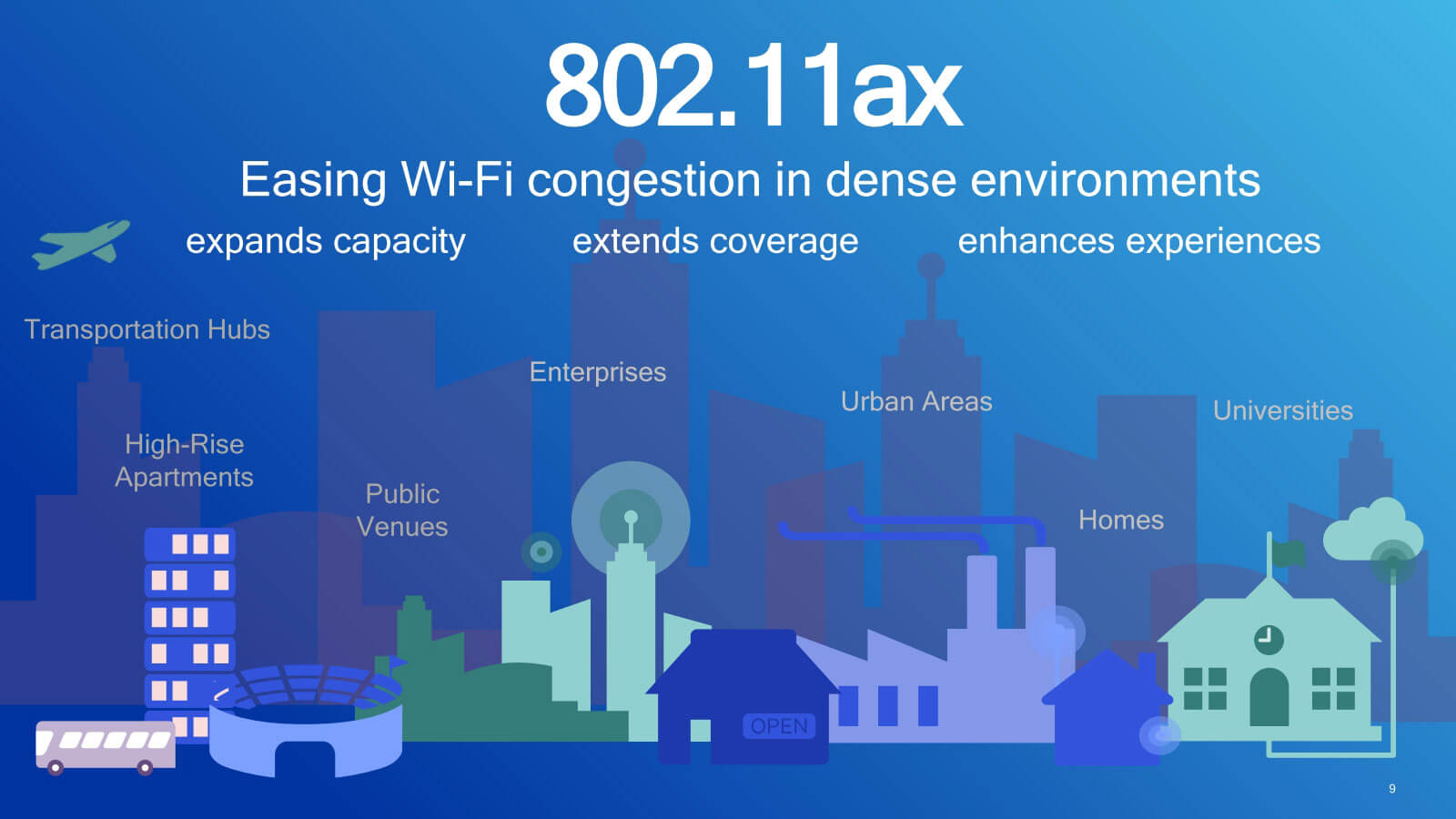
There aren’t at present many Wi-Fi 6 purchasers, so the adoption will take some time. The enhancements on this technology will not actually be felt till a bigger portion of gadgets makes use of the usual. As regular, Wi-Fi 6 is backwards suitable, however older gadgets will not be capable of make the most of the newer options.
Considering Wi-Fi 6 extra broadly, the increase in multi-user assist and notably the rise in simultaneous upstream connections are arriving alongside an accelerating demand for person information. This information will likely be gathered from IoT gadgets and used for functions akin to machine studying, fueling synthetic intelligence, the way forward for expertise as a complete and a rising digital financial system.
As talked about within the introduction of this text, routers are already obtainable primarily based on draft 802.11ax specs. We’re at present engaged on an up to date mesh roundup that includes the latest Wi-Fi 6 gadgets, so keep tuned for that.
Hold Studying. Explainers at TechSpot
Supply By https://www.techspot.com/article/1769-wi-fi-6-explained/






